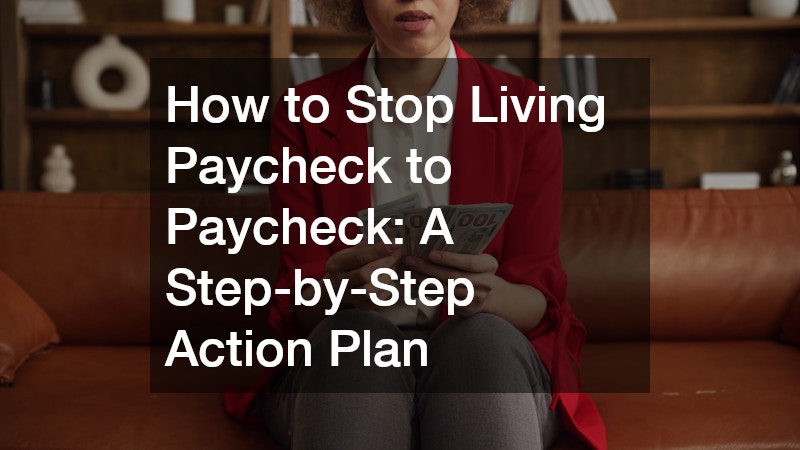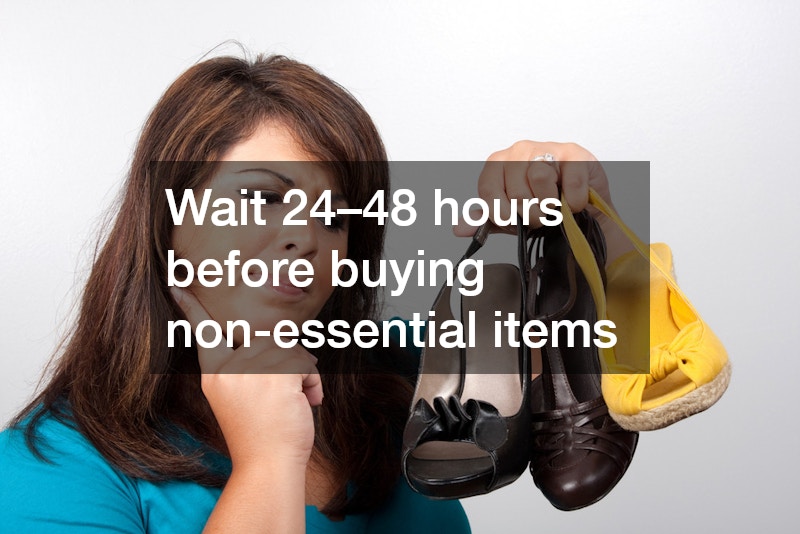
Living paycheck to paycheck can feel like running on a hamster wheel—no matter how hard you work, you can never get ahead. If this sounds familiar, you’re not alone. Many people struggle with managing money in a way that allows for financial freedom. The good news? It’s possible to break the cycle with a clear, actionable plan. In this guide, we’ll walk you through step by step how to stop living paycheck to paycheck and take control of your financial future.
Why Am I Always Running Out of Money?
Before making any changes, it’s important to understand why living paycheck to paycheck happens in the first place. Common causes include:
- Overspending on non-essential items – Impulse purchases and lifestyle inflation can quickly eat into your income.
- High fixed expenses – Rent, utilities, and debt payments can leave little wiggle room each month.
- Lack of budgeting – Without a plan for your money, it’s easy to spend more than you earn.
- Unexpected expenses – Emergencies like car repairs or medical bills can derail finances if there’s no cushion.
Recognizing the patterns in your spending is the first step toward change.
Step 1: Take a Hard Look at Your Finances
How can you manage money if you don’t know where it’s going? Start with a clear picture of your financial situation. Awareness is the foundation of change.
Track Your Income and Expenses
- Record every source of income – Include salary, freelance work, side hustles, or irregular income like bonuses. Knowing the total amount you bring in each month helps you set realistic goals.
- Write down all expenses – Include everything, from rent and utilities to small purchases like coffee, snacks, or apps. These “tiny leaks” can quietly consume hundreds of dollars over a month.
- Choose a tracking method – Spreadsheets, budgeting apps like Mint or YNAB, or even a simple notebook can work. The key is to consistently log every transaction.
- Review past statements – Examine bank and credit card records to identify subscriptions or repeated charges you might have forgotten.
Tip: Track for at least 30 days before making changes. Seeing actual numbers provides a wake-up call and eliminates guesswork.
Categorize Your Spending
- Fixed needs – Rent or mortgage, utilities, insurance, groceries. These are non-negotiable monthly costs.
- Variable needs – Fuel, extra groceries, household items. They fluctuate month to month but are still essential.
- Discretionary spending – Dining out, entertainment, hobbies, online shopping. This is where most adjustments happen.
- Debt payments – Loans, credit cards, or other recurring obligations.
Categorizing spending highlights areas to adjust without sacrificing essentials, making it easier to create a budget that works.
Calculate Your Net Income vs. Expenses
- Add up total income, subtract total expenses.
- Negative balance – Indicates you’re spending more than you earn.
- Barely positive – Shows little room for saving or emergencies.
Pro tip: Look for patterns. Are certain categories consistently overspending? Identifying problem areas is crucial before designing a budget.
Step 2: Create a Realistic Budget
A budget is your roadmap for escaping the paycheck-to-paycheck cycle. It gives you control over your money instead of letting money control you. The key is to keep it simple, realistic, and sustainable so that it fits your lifestyle without feeling restrictive.
50/30/20 Rule
The 50/30/20 rule is a straightforward guideline for dividing your income:
- 50% for needs – These are essential expenses you can’t avoid, such as rent or mortgage, utilities, groceries, transportation, insurance, and minimum debt payments. For example, if you earn $3,000 a month, $1,500 would go toward these essentials.
- 30% for wants – This includes non-essential spending that enhances your lifestyle, such as dining out, streaming subscriptions, hobbies, or shopping. Using the same $3,000 example, you’d allocate $900 for discretionary spending.
- 20% for savings and debt repayment – This portion goes toward building your emergency fund, investing, or paying down debts faster. In our example, $600 would go here.
Tip: Adjust the percentages slightly if your fixed costs are high, but try to maintain a balance between spending and saving.
Zero-Based Budgeting
Zero-based budgeting ensures every dollar has a purpose. The idea is simple: your income minus your expenses should equal zero at the end of the month.
- Assign every dollar – Every dollar you earn is given a specific job, whether it’s bills, savings, or leisure spending.
- Prevent “floating money” – Without a plan, extra cash often gets spent impulsively. Zero-based budgeting removes that risk.
- Example: If your monthly income is $3,000:
- $1,500 to needs
- $900 to wants
- $600 to savings and debt
- Total = $3,000 → every dollar accounted for.
Pro tip: Track expenses carefully to ensure that your planned allocations match reality. Apps like YNAB make this process easier by prompting you to assign every dollar.
Envelope System
The envelope system is a cash-based strategy that physically limits spending:
- How it works: Withdraw cash for specific categories (groceries, dining out, entertainment) and put it in envelopes. Once the money is gone, you can’t spend more for that category that month.
- Benefits: It creates a tangible limit, prevents overspending, and reinforces budgeting discipline.
- Example: You budget $300 for groceries and $100 for dining out. Put $300 in a “groceries” envelope and $100 in a “dining” envelope. When the cash is gone, you wait until next month.
Tip: Even if you prefer digital banking, you can simulate envelopes by creating separate accounts or sub-accounts for each category.
Step 3: Build an Emergency Fund
An emergency fund is your financial safety net.
- Start small – $500–$1,000 covers minor emergencies like car repairs or unexpected medical costs.
- Gradually grow – Aim for 3–6 months’ worth of living expenses for stronger security.
- Separate account – Keep it distinct from your checking account to reduce temptation.
This fund prevents reliance on credit cards or loans, helping you avoid stress and debt spirals.
Step 4: Reduce Your Debt Strategically
Debt is one of the biggest barriers to breaking the paycheck-to-paycheck cycle and achieving financial freedom. High-interest payments can drain your monthly income, leaving little room for savings or investments. Tackling debt strategically is essential.
List All Your Debts
Start by creating a clear picture of what you owe:
- Include every debt – Credit cards, personal loans, student loans, car loans, payday loans, and even store financing.
- Record key details – Note the current balance, interest rate, and minimum monthly payment for each.
- Organize by priority – This will help you choose which debts to tackle first, whether for motivation or cost efficiency.
Choose a Payoff Method
There are two common strategies to pay off debt:
Debt Snowball Method
- Focus on paying off the smallest balance first, while making minimum payments on larger debts.
- Once the smallest debt is cleared, roll its payment into the next smallest debt.
- Pros: Quick wins provide motivation and momentum.
- Example: Pay off $500 Credit Card B first, then apply its $25 + your normal $25 to Credit Card A.
Debt Avalanche Method
- Focus on paying off debts with the highest interest rates first, while paying minimums on lower-interest debts.
- Pros: Saves money on interest over the long term.
- Example: Pay extra toward 22% interest Credit Card B first, while continuing minimum payments on all other debts.
Tip: Choose the method that fits your personality—snowball for motivation, avalanche for efficiency.
Negotiate or Consolidate
- Negotiate lower interest rates – Call your credit card company or lender to ask for reduced rates. Even a few percentage points can save hundreds over time.
- Debt consolidation – Combine multiple high-interest debts into a single loan with a lower interest rate. This simplifies payments and can reduce the total interest paid.
- Balance transfer cards – If you qualify, transferring high-interest balances to a card with 0% introductory APR can provide breathing room to pay down debt faster.
Step 5: Cut Unnecessary Expenses
Small changes can add up quickly.
- Subscriptions – Cancel services you rarely use.
- Eating out – Meal prepping saves money and time.
- Energy usage – Switch to energy-efficient appliances and reduce unnecessary consumption.
- Transportation – Carpool, use public transport, or downsize your vehicle if possible.
Ask yourself: “Do I really need this?” before spending to reinforce mindful money habits.
Step 6: Increase Your Income
While cutting expenses is important, it’s often not enough to fully break the paycheck-to-paycheck cycle. There are several strategies you can combine depending on your skills, schedule, and resources.
Side Hustles
Side hustles are a flexible way to earn extra money outside your primary job. Some options include:
- Freelancing – Offer services in writing, graphic design, social media management, web development, or consulting. Platforms like Upwork, Fiverr, or Freelancer can help you find clients.
- Tutoring – Teach subjects you’re knowledgeable in, either online via platforms like Wyzant or in-person in your community.
- Online services – Virtual assistance, transcription, or managing online stores. Even small tasks like selling digital products or creating printables can generate extra income.
Pro tip: Treat side hustles like mini-businesses. Track your earnings and time spent to evaluate which options are most profitable and sustainable.
Overtime or Part-Time Work
If your current job allows, taking on extra hours can provide immediate income relief:
- Overtime – Even a few extra hours a week can make a significant difference in monthly cash flow.
- Part-time work – Retail, delivery, or hospitality jobs can provide flexible schedules that fit around your main job.
Example: If you earn $20/hour and work an extra 10 hours a week, that’s $200/week or roughly $800/month before taxes—a meaningful boost for debt repayment or savings.
Sell Unused Items
Decluttering not only frees up space but also generates extra cash:
- Clothing and accessories – Sell gently used items on platforms like eBay, Poshmark, or Facebook Marketplace.
- Electronics – Old phones, tablets, or gaming consoles can fetch decent prices.
- Household items – Furniture, kitchen appliances, or decor can sell quickly online or at garage sales.
Tip: Dedicate a weekend to decluttering and pricing items. Use the cash earned to fund your emergency fund or pay down high-interest debt.
Skills Development
Investing in your skills can increase your long-term earning potential:
- Short courses or certifications – Coding bootcamps, project management, or accounting courses can open doors to higher-paying roles.
- Networking and mentorship – Learning from experienced professionals can accelerate career growth and access better opportunities.
- Side business expansion – If your side hustle shows potential, invest in training to scale it.
Step 7: Automate Your Savings
Automation removes temptation and keeps savings consistent.
- Direct deposit – Split a portion of your paycheck into savings automatically.
- Recurring transfers – Schedule weekly or monthly contributions to emergency or investment accounts.
- Employer benefits – Use retirement plans or employer-matched contributions.
Automation ensures you consistently save without relying solely on willpower.
Step 8: Practice Mindful Spending
Mindful spending helps you prioritize what matters.
- Differentiate needs vs. wants – Essentials first; discretionary spending second.
- Delay purchases – Wait 24–48 hours before buying non-essential items.
- Track progress – Regularly review your budget and spending patterns.
Intentional spending reduces impulse purchases and long-term financial stress.
Step 9: Plan for the Future
Financial stability is about more than today—it’s long-term planning.
- Set financial goals – Short-term (vacation), medium-term (car, home), long-term (retirement).
- Invest wisely – Consider low-cost index funds, retirement accounts, or other growth opportunities.
- Review insurance coverage – Adequate protection against health, home, and car emergencies.
- Continuous learning – Stay updated on budgeting, investing, and financial strategies.
Forward planning ensures a sustainable, worry-free financial future.
Step 10: Stay Motivated
Changing habits takes time; motivation is essential.
- Celebrate small wins – Paying off a debt or hitting a savings milestone counts.
- Track visually – Charts, apps, or journals make progress tangible.
- Accountability partner – Share goals with someone who supports you.
- Focus on freedom, not deprivation – Each step moves you closer to independence.
Consistency over time is the ultimate solution to breaking the paycheck-to-paycheck cycle.
How to Stop Living Paycheck to Paycheck by Avoiding Common Mistakes
Even with a plan, mistakes can slow progress:
- Ignoring small expenses – Coffee, snacks, and subscriptions can add up.
- Using credit recklessly – High-interest debt can negate savings efforts.
- Overcomplicating budgets – Simpler systems are easier to maintain.
- Not adjusting your plan – Life changes; your budget should too.
FAQs About Escaping Paycheck-to-Paycheck Living
Q: How long does it take to stop living paycheck to paycheck?
A: It varies based on income, expenses, and debt. Some see progress in months; others may take a year or more. The key is consistent action.
Q: What if I can’t save much right now?
A: Start with small amounts, even $5–$10 per week. Building the habit is more important than the initial amount.
Q: Can I still have fun while saving?
A: Absolutely. Budget for entertainment, dining, and hobbies. The goal is balance, not deprivation.
Q: Should I pay off debt first or save first?
A: Focus on both. Start with a small emergency fund, then tackle high-interest debt while continuing to save gradually.
The Bottom Line: You Can Break Free
Living paycheck to paycheck can feel hopeless, but it doesn’t have to be permanent. By taking a close look at your finances, creating a realistic budget, reducing debt, and building savings, you can gain control over your money. Combining cost-cutting, income growth, and mindful spending sets the stage for long-term financial freedom.
Remember: change doesn’t happen overnight. Each small step adds up, and over time, you’ll create a life where your money works for you—not the other way around. Take control today, and you’ll thank yourself tomorrow.


